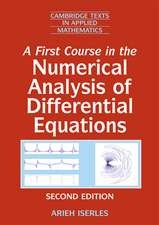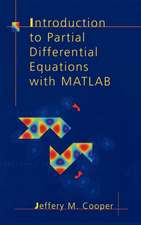Perturbation Methods for Differential Equations
Autor Bhimsen Shivamoggien Limba Engleză Hardback – 13 dec 2002
Toate formatele și edițiile
| Toate formatele și edițiile | Preț | Express |
|---|---|---|
| Paperback (1) | 392.60 lei 6-8 săpt. | |
| Birkhäuser Boston – 23 oct 2012 | 392.60 lei 6-8 săpt. | |
| Hardback (1) | 399.29 lei 6-8 săpt. | |
| Birkhäuser Boston – 13 dec 2002 | 399.29 lei 6-8 săpt. |
Preț: 399.29 lei
Nou
Puncte Express: 599
Preț estimativ în valută:
76.43€ • 83.05$ • 64.24£
76.43€ • 83.05$ • 64.24£
Carte tipărită la comandă
Livrare economică 21 aprilie-05 mai
Preluare comenzi: 021 569.72.76
Specificații
ISBN-13: 9780817641894
ISBN-10: 0817641890
Pagini: 354
Ilustrații: XIV, 354 p.
Dimensiuni: 155 x 235 x 23 mm
Greutate: 0.68 kg
Ediția:2003
Editura: Birkhäuser Boston
Colecția Birkhäuser
Locul publicării:Boston, MA, United States
ISBN-10: 0817641890
Pagini: 354
Ilustrații: XIV, 354 p.
Dimensiuni: 155 x 235 x 23 mm
Greutate: 0.68 kg
Ediția:2003
Editura: Birkhäuser Boston
Colecția Birkhäuser
Locul publicării:Boston, MA, United States
Public țintă
Lower undergraduateCuprins
1 Asymptotic Series and Expansions.- 1.1 Introduction.- 1.2 Taylor Series Expansions.- 1.3 Gauge Functions.- 1.4 Asymptotic Series and Expansions.- 1.5 Asymptotic Solutions of Differential Equations.- 1.6 Exercises.- 2 Regular Perturbation Methods.- 2.1 Introduction.- 2.2 Algebraic Equations.- 2.3 Ordinary Differential Equations.- 2.4 Partial Differential Equations.- 2.5 Applications to Fluid Dynamics: Decay of a Line Vortex.- 2.6 Exercises.- 2.7 Appendix. Review of Partial Differential Equations.- 3 The Method of Strained Coordinates/Parameters.- 3.1 Introduction.- 3.2 Poincaré-Lindstedt-Lighthill Method of Perturbed Eigenvalues.- 3.3 Eigenfunction Expansion Method.- 3.4 Lighthill’s Method of Shifting Singularities.- 3.5 Pritulo’s Method of Renormalization.- 3.6 Wave Propagation in an Inhomogeneous Medium.- 3.7 Applications to Solid Mechanics: Nonlinear Buckling of Elastic Columns.- 3.8 Applications to Fluid Dynamics.- 3.9 Applications to Plasma Physics.- 3.10 Limitations of the Method of Strained Parameters.- 3.11 Exercises.- 3.12 Appendix 1. Fredholm’s Alternative Theorem.- 3.13 Appendix 2. Floquet Theory.- 3.14 Appendix 3. Bifurcation Theory.- 4 Method of Averaging.- 4.1 Introduction.- 4.2 Krylov-Bogoliubov Method of Averaging.- 4.3 Krylov-Bogoliubov-Mitropolski Generalized Method of Averaging.- 4.4 Whitham’s Averaged Lagrangian Method.- 4.5 Hamiltonian Perturbation Method.- 4.6 Applications to Fluid Dynamics: Nonlinear Evolution of Modulated Gravity Wave Packet on the Surface of a Fluid.- 4.7 Exercises.- 4.8 Appendix 1. Review of Calculus of Variations.- 4.9 Appendix 2. Hamilton-Jacobi Theory.- 5 The Method of Matched Asymptotic Expansions.- 5.1 Introduction.- 5.2 Physical Motivation.- 5.3 The Inner and Outer Expansions.- 5.4 Hyperbolic Equations.- 5.5Elliptic Equations.- 5.6 Parabolic Equations.- 5.7 Interior Layers.- 5.8 Latta’s Method of Composite Expansions.- 5.9 Turning Point Problems.- 5.10 Applications to Fluid Dynamics: Boundary-Layer Flow Past a Flat Plate.- 5.11 Exercises.- 5.12 Appendix 1. Initial-Value Problem for Partial Differential Equations.- 5.13 Appendix 2. Review of Nonlinear Hyperbolic Equations.- 6 Method of Multiple Scales.- 6.1 Introduction.- 6.2 Differential Equations with Constant Coefficients.- 6.3 Struble’s Method.- 6.4 Differential Equations with Slowly Varying Coefficients.- 6.5 Generalized Multiple-Scale Method.- 6.6 Applications to Solid Mechanics: Dynamic Buckling of a Thin Elastic Plate.- 6.7 Applications to Fluid Dynamics.- 6.8 Applications to Plasma Physics.- 6.9 Exercises.- 7 Miscellaneous Perturbation Methods.- 7.1 A Quantum-Field-Theoretic Perturbative Procedure.- 7.2 A Perturbation Method for Linear Stochastic Differential Equations.- 7.3 Exercises.
Recenzii
From the reviews:
"The book is concerned...with singular perturbation phenomena for ordinary and partial differential equations. Instead of presenting general theory, the author shows how various perturbation techniques work in concrete examples. . . . Applications are quite numerous and include fluid dynamics, solid mechanics, and plasma physics. . . . A great variety of examples coming from real applications makes the book a very nice source for courses on perturbation methods. A number of exercises together with appendices covering some mathematical topics used in the text help a lot in making it practically self-contained." —Mathematical Reviews
This book is focused on perturbation methods mainly applied to solve both ordinary and partial differential equations … One of the unusual features of the treatment is motivated by the author’s notes devoted to a mix of students in applied mathematics, physics, and engineering. Therefore, it is intended to serve as a textbook for undergraduate students of the previously mentioned branches of science. The book can serve also as an example of how an asymptotic analysis may easily move between various disciplines … Since the book covers a great deal of material, it is recommended to students and researchers already familiar with solid and fluid mechanics, as well as with plasma physics.” —Applied Mechanics Review
"This monograph presents an overall introduction to singular perturbation methods…. [It] aims to describe the procedures and the intuitive ideas underlying the above methods. The author deliberately side-stepped the theoretical aspects and the mathematical proofs. Also, the theory is principally explained from examples. The result is a variety of problems, some of them with a physical background which is briefly described…. The exposition of ideas and computations are quite clear. The mathematicsused by the author does not go far beyond an advanced calculus course…. It is valuable to have a book that can be used as a graduate text for students in applied mathematics, physics and engineering. The present book achieves this goal. It…will be useful to engineers and applied mathematicians who wish to obtain some, possibly formal, answer[s] to their problems. It can also be used by the mathematician as an overview o[f] the field…. As a conclusion, this work can be recommended as a good textbook for a graduate course in applied mathematics." —Zentralblatt Math
"The book is devoted to the subject of seeking nonlinear solutions in the neighborhood (or as a perturbation) about a known linear solutions. It adopts a straightforward intuitive approach and pays more attention to the procedures and underlying ideas than to mathematical rigour." —Quarterly of Appl. Math.
"This book presents the regular pertubation methods for differential and partial differential equations. Other methods...are also [presented in detail]. Very important is the fact that each chapter contains certain important applications, especially to fluid dynamics, but also to solid mechanics and plasma physics. Moreover, each chapter contains a section of specific exercises, and an appendix with basic mathematical tools. Many methods and procedures are very well described without technical proofs.... [The book] can serve as a textbook for undergraduate students in applied mathematics, physics, and engineering. Researchers in these areas will also find the book an excellent reference." —Rev. D'Anal. Num. Théorie de L'Approx.
"The present textbook shows how to find approximate solutions to nonlinear differential equations (both ordinary and partial) by means of asymptotic expansions. It discusses different singular perturbation methods (strained parameters, averaging, matchedasymptotic expansions, multiple-scale, and quantum-field-theoretic renormalization) in an informal manner using specific examples from applications. It is easy to read and suitable for advanced undergraduate students requiring only some basic knowledge of [ODEs]." —Monatshefte für Mathematik
"The book is concerned...with singular perturbation phenomena for ordinary and partial differential equations. Instead of presenting general theory, the author shows how various perturbation techniques work in concrete examples. . . . Applications are quite numerous and include fluid dynamics, solid mechanics, and plasma physics. . . . A great variety of examples coming from real applications makes the book a very nice source for courses on perturbation methods. A number of exercises together with appendices covering some mathematical topics used in the text help a lot in making it practically self-contained." —Mathematical Reviews
This book is focused on perturbation methods mainly applied to solve both ordinary and partial differential equations … One of the unusual features of the treatment is motivated by the author’s notes devoted to a mix of students in applied mathematics, physics, and engineering. Therefore, it is intended to serve as a textbook for undergraduate students of the previously mentioned branches of science. The book can serve also as an example of how an asymptotic analysis may easily move between various disciplines … Since the book covers a great deal of material, it is recommended to students and researchers already familiar with solid and fluid mechanics, as well as with plasma physics.” —Applied Mechanics Review
"This monograph presents an overall introduction to singular perturbation methods…. [It] aims to describe the procedures and the intuitive ideas underlying the above methods. The author deliberately side-stepped the theoretical aspects and the mathematical proofs. Also, the theory is principally explained from examples. The result is a variety of problems, some of them with a physical background which is briefly described…. The exposition of ideas and computations are quite clear. The mathematicsused by the author does not go far beyond an advanced calculus course…. It is valuable to have a book that can be used as a graduate text for students in applied mathematics, physics and engineering. The present book achieves this goal. It…will be useful to engineers and applied mathematicians who wish to obtain some, possibly formal, answer[s] to their problems. It can also be used by the mathematician as an overview o[f] the field…. As a conclusion, this work can be recommended as a good textbook for a graduate course in applied mathematics." —Zentralblatt Math
"The book is devoted to the subject of seeking nonlinear solutions in the neighborhood (or as a perturbation) about a known linear solutions. It adopts a straightforward intuitive approach and pays more attention to the procedures and underlying ideas than to mathematical rigour." —Quarterly of Appl. Math.
"This book presents the regular pertubation methods for differential and partial differential equations. Other methods...are also [presented in detail]. Very important is the fact that each chapter contains certain important applications, especially to fluid dynamics, but also to solid mechanics and plasma physics. Moreover, each chapter contains a section of specific exercises, and an appendix with basic mathematical tools. Many methods and procedures are very well described without technical proofs.... [The book] can serve as a textbook for undergraduate students in applied mathematics, physics, and engineering. Researchers in these areas will also find the book an excellent reference." —Rev. D'Anal. Num. Théorie de L'Approx.
"The present textbook shows how to find approximate solutions to nonlinear differential equations (both ordinary and partial) by means of asymptotic expansions. It discusses different singular perturbation methods (strained parameters, averaging, matchedasymptotic expansions, multiple-scale, and quantum-field-theoretic renormalization) in an informal manner using specific examples from applications. It is easy to read and suitable for advanced undergraduate students requiring only some basic knowledge of [ODEs]." —Monatshefte für Mathematik














